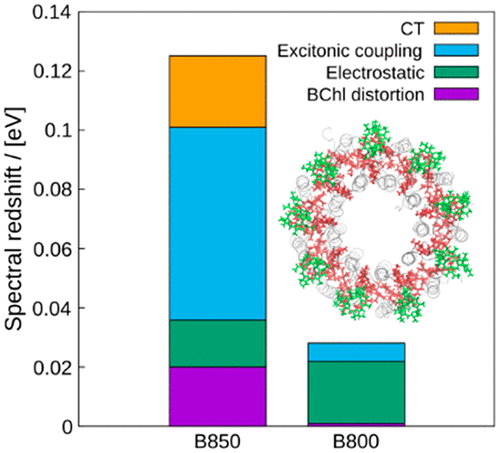当前位置:
X-MOL 学术
›
J. Phys. Chem. B
›
论文详情
Our official English website, www.x-mol.net, welcomes your
feedback! (Note: you will need to create a separate account there.)
Spectral Tuning Mechanism of Photosynthetic Light-Harvesting Complex II Revealed by Ab Initio Dimer Exciton Model
The Journal of Physical Chemistry B ( IF 2.8 ) Pub Date : 2021-09-15 , DOI: 10.1021/acs.jpcb.1c04457 Kazuhiro J Fujimoto 1, 2 , Takumi Minoda 2 , Takeshi Yanai 1, 2
The Journal of Physical Chemistry B ( IF 2.8 ) Pub Date : 2021-09-15 , DOI: 10.1021/acs.jpcb.1c04457 Kazuhiro J Fujimoto 1, 2 , Takumi Minoda 2 , Takeshi Yanai 1, 2
Affiliation

|
Excited states of two kinds of bacteriochlorophyll (BChl) aggregates, B850 and B800, in photosynthetic light-harvesting complex II (LH2) are theoretically investigated by developing and using an extended exciton model considering efficiently evaluated excitonic coupling. Our exciton model based on dimer fragmentation is shown to reproduce the experimental absorption spectrum of LH2 with good accuracy, entailing their different redshifts originating from aggregations of B850 and B800. The systematic analysis has been performed on the spectra by quantitatively decomposing their spectral shift energies into the contributions of various effects: structural distortion, electrostatic, excitonic coupling, and charge-transfer (CT) effects. Our results show that the spectral redshift of B800 is mainly attributed to its electrostatic interaction with the protein environment, while that of B850 arises from the marked effect of the excitonic coupling between BChl units. The interchromophore CT excitation also plays a key role in the spectral redshift of B850. This CT effect can be effectively described using our dimer model. This suited characterization reveals that the pronounced CT effect originates from the characteristics of B850 that has closely spaced BChls as dimers. We highlight the importance of the refinement of the crystal structure with the use of quantum chemical methods for prediction of the spectrum.
中文翻译:

Ab Initio Dimer Exciton 模型揭示光合光捕获复合物 II 的光谱调谐机制
两种细菌叶绿素 (BChl) 聚集体 B850 和 B800 在光合光捕获复合物 II (LH2) 中的激发态通过开发和使用考虑有效评估激子耦合的扩展激子模型进行了理论上的研究。我们基于二聚体碎裂的激子模型显示出以良好的精度重现 LH2 的实验吸收光谱,从而导致它们不同的红移源自 B850 和 B800 的聚集。通过将光谱位移能量定量分解为各种效应的贡献,对光谱进行了系统分析:结构畸变、静电、激子耦合和电荷转移 (CT) 效应。我们的结果表明,B800 的光谱红移主要归因于其与蛋白质环境的静电相互作用,而 B850 的光谱红移则源于 BChl 单元之间激子耦合的显着影响。发色团间 CT 激发也在 B850 的光谱红移中起关键作用。使用我们的二聚体模型可以有效地描述这种 CT 效应。这种合适的表征表明显着的 CT 效应源于 B850 的特性,它具有作为二聚体的紧密间隔的 BChl。我们强调了使用量子化学方法来预测光谱来改进晶体结构的重要性。发色团间 CT 激发也在 B850 的光谱红移中起关键作用。使用我们的二聚体模型可以有效地描述这种 CT 效应。这种合适的表征表明显着的 CT 效应源于 B850 的特性,它具有作为二聚体的紧密间隔的 BChl。我们强调了使用量子化学方法来预测光谱来改进晶体结构的重要性。发色团间 CT 激发也在 B850 的光谱红移中起关键作用。使用我们的二聚体模型可以有效地描述这种 CT 效应。这种合适的表征表明显着的 CT 效应源于 B850 的特性,它具有作为二聚体的紧密间隔的 BChl。我们强调了使用量子化学方法来预测光谱来改进晶体结构的重要性。
更新日期:2021-09-23
中文翻译:

Ab Initio Dimer Exciton 模型揭示光合光捕获复合物 II 的光谱调谐机制
两种细菌叶绿素 (BChl) 聚集体 B850 和 B800 在光合光捕获复合物 II (LH2) 中的激发态通过开发和使用考虑有效评估激子耦合的扩展激子模型进行了理论上的研究。我们基于二聚体碎裂的激子模型显示出以良好的精度重现 LH2 的实验吸收光谱,从而导致它们不同的红移源自 B850 和 B800 的聚集。通过将光谱位移能量定量分解为各种效应的贡献,对光谱进行了系统分析:结构畸变、静电、激子耦合和电荷转移 (CT) 效应。我们的结果表明,B800 的光谱红移主要归因于其与蛋白质环境的静电相互作用,而 B850 的光谱红移则源于 BChl 单元之间激子耦合的显着影响。发色团间 CT 激发也在 B850 的光谱红移中起关键作用。使用我们的二聚体模型可以有效地描述这种 CT 效应。这种合适的表征表明显着的 CT 效应源于 B850 的特性,它具有作为二聚体的紧密间隔的 BChl。我们强调了使用量子化学方法来预测光谱来改进晶体结构的重要性。发色团间 CT 激发也在 B850 的光谱红移中起关键作用。使用我们的二聚体模型可以有效地描述这种 CT 效应。这种合适的表征表明显着的 CT 效应源于 B850 的特性,它具有作为二聚体的紧密间隔的 BChl。我们强调了使用量子化学方法来预测光谱来改进晶体结构的重要性。发色团间 CT 激发也在 B850 的光谱红移中起关键作用。使用我们的二聚体模型可以有效地描述这种 CT 效应。这种合适的表征表明显着的 CT 效应源于 B850 的特性,它具有作为二聚体的紧密间隔的 BChl。我们强调了使用量子化学方法来预测光谱来改进晶体结构的重要性。











































 京公网安备 11010802027423号
京公网安备 11010802027423号